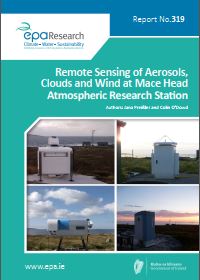Authors: Jana Preißler and Colin O’Dowd
Summary: The power of remote sensing lies in its ability to automatically and continuously characterise parts of the atmosphere that can be far away from the sensor, e.g. at high altitudes from the ground in the case of this study. This fellowship focused on continuous high-resolution (vertical and temporal) profiling of the atmosphere over Mace Head Atmospheric Research Station using active and passive ground-based remote sensing techniques.

The anthropogenic impact on air quality, weather and climate, and by extension on the economy, is a present concern for scientists, policymakers and the public. In recent years, attention has also been drawn towards the hazards that volcanic eruptions pose to the economy, air quality and human health. These events, although infrequent, can have a very strong impact on the Irish public by disrupting air traffic, increasing air pollution and affecting health. This project focused on continuous high-resolution (vertical and temporal) profiling of the atmosphere over Mace Head Atmospheric Research Station using active and passive ground-based remote sensing techniques to address some of these challenges. A cloud radar, ceilometer, microwave radiometer and wind lidar were used to obtain profiles of cloud properties, aerosol concentration, temperature, humidity, and wind characteristics (speed, direction, shear, turbulence).
As well as contributing to high-impact research studies in past years, remote sensing data were sent to the European-scale networks Cloudnet and E-Profile for joint processing and large-scale studies. The existence of such networks underlines the importance of ground-based remote sensing of the atmosphere on a continental scale. Remote sensing at Mace Head provides a large part of the Irish contribution to these pan-European networks. For a comprehensive view of the atmosphere over the Irish west coast and subsequently a better understanding and forecast of atmospheric processes such as storms, extreme pollution events and the effects of climate change, remote sensing at Mace Head is invaluable. Continuous operation is crucial to study the complexity of coastal atmospheric processes, and automatic processing is necessary to handle large amounts of data and distil essential information from the data.
The transport of man-made and naturally occurring pollutants, their quantification and characterisation, and their interaction with clouds and therefore their impact on the climate can be studied with the help of active and passive remote sensing instruments. Sophisticated sensors on the ground enable highly temporally and vertically resolved observations of atmospheric components such as clouds and aerosols, as well as atmospheric parameters such as wind speed, wind direction, temperature and humidity, to be carried out. The remote sensing division of the Mace Head Atmospheric Research Station includes all of these capabilities. In addition, the large set of co-located ground-based in situ instrumentation for the measurement of aerosol properties can aid in the accurate characterisation of pollutants and forms the link from the ground to vertical profiles provided by the remote sensing instruments. The detection of transboundary transport of air pollution was addressed with the suite of remote sensing instruments at Mace Head, in combination with transport models and trajectories. These tools enable the identification of aerosol origin and thus support the characterisation of emission sources. With Mace Head’s capabilities we can also detect volcanic aerosol plumes (ash particles, as well as sulfuric acid droplets). With the closest volcanic sources located in Iceland, Mace Head is a prime site for early detection of such plumes. The remote sensing data can be used to alert Ireland and Europe about volcanic aerosol advection in the case of westerly and north-westerly winds.
https://www.epa.ie/media/epa-2020/publications/research/Thumbnail_319[1].jpg